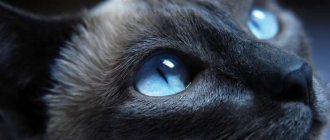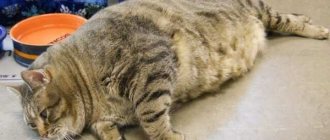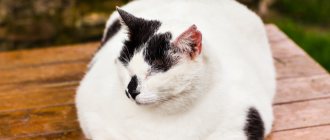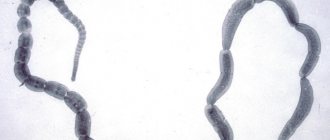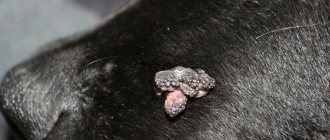Every caring owner carefully monitors the health of their pets. If any disease occurs, the pet's appearance may deteriorate significantly. For example, many may notice cloudy eyes in a cat. Cloudy eyes often occur due to damage to the lens or cornea. This is due to the accumulation of excess liquid in them. People often call this deviation the simple word “thorn.” In this case, usually one eye becomes cloudy. However, in particularly severe stages, damage may occur to both eyes at once. What are the main causes of pathology and how can it be combated?
Characteristic symptoms
Doctors distinguish several degrees of damage to the organ of vision:
- peripheral (a border is observed at the edges of the eyeball);
- central (clouding of the eye is noted in the very center);
- total (the cat’s organ of vision is completely closed).
In most cases, if a kitten has a cloudy eye, there will be accompanying symptoms.
Entropion of the eyelids
This is an incorrect position of the upper and/or lower eyelids, in which the free edge of the eyelid is shifted inward towards the eyeball.
Symptoms:
— Eyelashes and hair on the eyelids, when turned in, greatly irritate the eye.
— The cat squints its eyes a lot.
- There is severe lacrimation or purulent discharge. Constant irritation can lead to corneal injury.
Treatment:
1. Surgical. With spastic volvulus, therapy is aimed at eliminating the underlying disease, but in some cases, after eliminating the cause that caused the spastic volvulus, it is still necessary to resort to surgical correction.
============================================================================================================================================================================================
Cloudy eye in a cat: signs
If a cat's eye is cloudy, then at first glance he appears to be blind. However, this is not always the case. There is only one sign of cloudy eyes in an animal – a white veil.
A cat's eye can become cloudy for a variety of reasons.
But over time, other symptoms may appear, for example:
- Blepharospasm and photophobia.
- Swelling of the conjunctiva.
- Irritability.
- Protrusion of the eye from the socket.
- Enlargement of the eyeball.
- Dilatation of blood vessels in the eye.
- The presence of purulent or mucous discharge from the eyes.
- Sleep disturbance.
- Loss of appetite.
You should not wait for signs of complications to appear, and if you notice clouding of the eye, you should immediately contact a veterinarian.
Relevance of the problem
If a cat's eye becomes cloudy, it appears as if he is blind. But it is not always the case. To determine the true cause of blurred vision in a pet, you need to contact a veterinarian-ophthalmologist.
The fact is that the causes of this eye pathology can be various diseases: cataracts, keratitis, glaucoma, uveitis. They can only be recognized in a veterinary clinic using special equipment.
Most common reasons
Often changes in eye condition are observed due to the development of cataracts, glaucoma, and corneal damage. It is worth considering each of these conditions separately.
Cataract
At the initial stage, changes occur deep in the organ. There is clouding of the pupil. One or two eyes may be affected. With further development of the pathological process, the lens loses its transparency and becomes white.
This happens for the following reasons:
- injury;
- past infectious diseases;
- inflammatory processes;
- metabolic disorders in older animals.
Sometimes congenital cataracts are observed.
Glaucoma
As intraocular pressure increases, the eyeball increases in size. There is loss of vision.
The following symptoms are observed:
- the cornea becomes cloudy, acquires a white tint, and loses sensitivity;
- the pupil dilates;
- the animal suffers from problems with coordination of movements.
The cat bumps into various objects not because of vestibular disorders, but because of blindness. As the disease progresses, the mucous membranes harden.
Eye diseases
One of the most common causes of cloudy eyes in a cat is the presence of one or another pathology associated with this organ of vision. Of course, not all eye diseases lead to clouding of the eye, therefore in this chapter we will focus on those ailments that are directly related to the topic of this article.
Eye diseases pose a danger to both weakened and completely healthy animals.
Cataract
All cat owners have probably heard about cataracts, if not through the example of animals, then at least through the example of people. The disease itself, regardless of who was exposed to it - a cat or a person, proceeds in a similar way and has similar symptoms. If we describe the manifestations of cataracts very briefly, we can say that it is a gradual enveloping of the eye with a white-gray veil. This disease occurs for the following reasons:
- advanced age of the individual and accompanying changes in the body;
- diseases of the endocrine system;
- mechanical damage to the eye (and in particular to the pupil);
- genetic predisposition (cataracts are more common in Persian, Siamese and Burmese breeds).
Some purebred cats are more likely to develop eye pathology
Stages of development
In its progression, cataracts go through several stages, causing the animal more and more discomfort.
Table 1. Stages of cataract development
| Stage | Features of the course |
| Initial | In the initial stages, it is almost impossible to recognize cataracts in a pet, since visual impairment is minor and does not affect the cat’s lifestyle. Cloudiness appears only at the edges of the lens and is almost invisible to the inexperienced eye of the owner |
| Immature | The quality of vision continues to deteriorate, and the cat begins to see objects as unclear and blurry. Gradually the veil approaches the middle of the lens. At this stage, the owner can already observe changes in the pet’s habits, but often they are not so significant as to start sounding the alarm. |
| Mature | At this stage, the animal completely ceases to recognize objects and can only distinguish between light and darkness. It loses the ability to move independently in unfamiliar spaces, but by memory it orients itself in its home, relying on tactile sensations. Changes in behavior are obvious |
| Overripe | The animal loses the ability to perceive even light or its absence. At this stage, the lens disintegrates into fibers and loses absolutely all its functions. The animal becomes unviable and constantly needs a “guide” |
Treatment
Unfortunately, cataract treatment is not always successful. The treatment methods themselves depend on the stage at which the disease was detected. As a rule, most owners take their pet to the veterinarian already at the immature stage, when clouding becomes obvious. If, nevertheless, the need for a doctor was recognized in a timely manner, then the specialist prescribes special drops for the pet, and also determines the causes of cataracts and precisely hits them. Such reasons may be:
- diabetes;
- diseases of the endocrine system;
- urolithiasis disease;
- incorrect use of certain drugs;
- improper diet;
- the presence of parasites in the body;
- glaucoma and other eye diseases that indirectly damage the lens.
If cataracts are detected early, treatment may be limited to eye drops.
If a cat comes to the veterinarian at an advanced stage of cataract development, then a decision is made to perform a special operation that will preserve the animal’s vision. The essence of this operation is to remove the damaged segment of the lens and replace it with a high-quality duplicate.
Video - Surgery to remove cataracts in a cat
Glaucoma
Glaucoma involves increased intraocular pressure and involves an enlargement of the eye, causing it to appear painfully swollen. This pathology is rarely an independent disease, but rather a complication that develops against the background of uveitis. In the absence of uveitis, the following factors can cause glaucoma:
- mechanical damage to the eye;
- hyphema;
- lens displacement;
- perforated ulcer of the cornea of the eye.
Glaucoma is often one of the symptoms in a more global clinical picture
Glaucoma often occurs due to the formation of an excessive amount of intraocular fluid or problems with its outflow.
Symptoms
Glaucoma in a cat can be recognized by the following characteristic manifestations:
- the animal's eyes turn red;
- increased tearfulness appears;
- the eye gradually enlarges, while the pupil loses light sensitivity (which is why the cat begins to avoid well-lit places in every possible way);
- the cornea becomes cloudy and ulcers may appear on it;
- eyelids swell;
- the animal experiences pain when blinking and constantly squints.
Glaucoma significantly complicates a cat's orientation in space
If we talk about the cat’s behavior itself, then over time it becomes more and more cautious. Deterioration of vision naturally leads to a lack of coordination, which is why the pet begins to give preference to low and familiar areas in the house, avoiding jumping on cabinets and other “tops.” When descending even from such low objects as a table or sofa, the animal shows unusual uncertainty for it and may seem clumsy.
Treatment
Glaucoma is a serious disease that requires ongoing treatment throughout the cat's life. The main emphasis when choosing therapy is on antihypertensive drops, which help maintain the animal’s vision at an acceptable level. The veterinarian selects the specific type of drops and their dosage depending on the causes of glaucoma, as well as on the magnitude of the pressure itself.
In the initial stages, glaucoma is removed with eye drops with a hypotensive effect
Antihypertensive drugs perform two main functions:
- suppression of intraocular fluid production;
- correction of its outflow.
The therapy itself requires periodic changes, since sensitivity to different medications may fluctuate, requiring periodic adjustments to the treatment regimen.
Keratitis
Keratitis is an inflammation of the cornea of the eye and in the vast majority of cases is acquired. Congenital “predisposition” to this pathology is extremely rare. Among the reasons that provoke keratitis, we will briefly describe the main ones:
- mechanical damage to the eye (grains of sand, dust, blades of grass, etc. getting into the eye);
- chemical or thermal burn of the eye;
- infectious diseases such as rhinotracheitis, calcivirosis and adenovirus;
- allergic reaction;
- blockage of the lacrimal glands;
- lack of vitamins;
- untreated conjunctivitis;
- heredity.
A common cause of keratitis is a violation of the outflow of tear fluid.
Symptoms
In most animals, keratitis occurs in the context of similar manifestations, such as:
- corneal clouding. To the naked eye, the cornea may appear matte;
- swelling of the upper layer of the eye as a result of excessive accumulation of fluid in the cornea;
- profuse lacrimation, causing hair to stick together around the eyes, and sometimes in other areas of the muzzle;
- accumulation of pus in the inner corners of the eyes;
- germination of the cornea by vessels;
- scarring of the cornea (occurs in advanced stages of the disease);
- photophobia.
In some cases, keratitis can develop against the background of cat runny nose - rhinotracheitis
In the absence of treatment or if contacting a veterinarian is too late, the prognosis can be unfavorable. In the worst cases, the cat completely loses the ability to see. However, if the disease was noticed on time, the veterinarian has time to find the cause that led to this complication and correctly eliminate it.
Treatment
The treatment regimen is selected by the doctor depending on three factors, including:
- illness that provoked keratitis;
- degree of neglect of the disease;
- degree of corneal damage.
Before prescribing treatment, the veterinarian must assess the degree of preservation of the eye.
The treatment itself involves the use of the following means:
- ointments;
- eye drops;
- injections (injected under the conjunctiva, and in some cases subcutaneous);
- pills.
If there is a possibility of corneal perforation, the animal is prescribed plastic surgery that can prevent such a development of events.
Uveitis
Uveitis involves inflammation of the uvea of the eye, which is very painful for the animal, which is forced to constantly squeeze the eyelids in order to somehow reduce the spasm. Along with all the diseases listed, uveitis is a serious disease that affects all structures of the eyeball and can lead a cat to complete loss of vision.
Uveitis is often accompanied by swelling of the third eyelid, the existence of which the owner was not aware of
It should be noted that the reasons for the development of this pathology in some cats remain mysterious, since it can affect a completely healthy body. Among the provoking diseases that contribute to the appearance of uveitis are the following:
- rhinotracheitis;
- toxoplasmosis;
- chlamydia;
- candidiasis;
- blastomycosis;
- various neoplasms, such as melanoma or lymphoma.
Uveitis can also be caused by household injuries, as a result of which foreign objects injure the surface layers of the eye.
Comparison of healthy and diseased cat eyes
Symptoms
Uveitis has a rich “bouquet” of clinical manifestations that manifest themselves in different animals individually. Therefore, the symptoms given below should not be considered as a set of signs required for all cats, but as a general picture. So, uveitis can be accompanied by the following symptoms:
- redness of the conjunctiva and sclera;
- photophobia;
- volvulus of the third eyelid;
- increased tearfulness;
- clouding of the retina, accompanied by the appearance of an unnatural matte reflection;
- change in the color of the iris - the new shade becomes more “dirty”;
- blepharospasm, due to which the animal constantly squints and closes its eyes;
- strabismus.
Uveitis may be the “initial stage” of cataracts
Uveitis is not always an independent disease and can manifest itself in the context of pathologies such as cataracts or glaucoma. We can say that all these diseases are interconnected, since glaucoma can also provoke cataracts.
Treatment
Due to the fact that uveitis tends to develop against the background of existing diseases, its treatment is accompanied by a thorough diagnosis of the pet, which includes the following procedures:
- measurement of intraocular pressure;
- general and biochemical blood test;
- tests for the presence of infectious diseases;
- tests for the presence of pathologies that are systemic in nature.
Measuring intraocular pressure in cats
Full recovery of your pet is possible with early contact with a specialist and selection of a competent treatment regimen. A favorable prognosis applies to the anterior type of uveitis. If anterior uveitis is combined with posterior uveitis, there is a high probability of developing various complications (consisting, for example, in adhesions between the iris and cornea), which leave a significant imprint on the life of the cat. The main thing that a specialist is trying to prevent in this situation is retinal detachment and the resulting blindness of the animal.
Common causes of cloudy eyes in cats
The most common causes of cloudy eyes are glaucoma, cataracts or keratitis. These problems are increasingly being identified in cats of different breeds and ages.
Glaucoma
When a cat has glaucoma, the intraocular pressure increases, the size of the eyes changes, and vision begins to disappear.
The cat owner may also notice the following changes:
- the pupil is dilated;
- the cornea is almost white;
- coordination is impaired.
But the cat mostly bumps into surrounding objects only because it doesn’t see well. Moreover, the disease can affect both eyes at once. The cause of glaucoma, which can be congenital or acute, can be a severe form of keratitis or lens luxation.
Cataract
A cataract is a clouding of the eye that begins at the pupil. The lens may completely lose its transparency. The disease can be caused by an inflammatory disease of the eye, trauma, or a previous infection. Most often, this problem occurs in older cats due to metabolic disorders.
Cloudiness of the eye can occur due to cataracts.
Corneal lesions (keratitis)
In this case, clouding of the surface of the eye is observed. It can begin to grow from any area of the eye, resembling the gradual stretching of a dense film. Keratitis in cats occurs due to an inflammatory process in the tissues of the cornea, or due to an infection in the eye. It is not uncommon for the eye to become cloudy after an injury. In any form, keratitis is a serious problem.
Keratitis is also a consequence of age-related disorders, untreated conjunctivitis, and the formation of ulcers on the corneas.
Scar (thorn) of the cornea
A scar or cataract of the cornea causes it to become cloudy after injury, burns or ulcers. There are several types of pathology:
- peripheral cataract, it is located away from the pupil and does not have a significant harmful effect on vision;
- a total cataract that covers the pupil and cornea. Vision deteriorates significantly;
- central thorn. It is located on the pupil, covering it partially or completely. The field of view becomes limited.
INTERESTING TO KNOW: Problems of the third eyelid in a cat
Partial or complete restoration of the cornea in this pathology is possible only with timely professional treatment.
Causes of clouding and damage to the lens
The pupil of the eye itself does not lose transparency, since it is a hole in the iris. The transparent biolens of the organ of vision, called the lens, becomes cloudy. It is located behind the pupil.
The main cause of clouding is considered to be cataracts. This pathology manifests itself for several reasons:
- changes in metabolism associated with the age of the animal (old individuals);
- endocrine diseases - lipid metabolism disorders, diabetes mellitus;
- pupil injuries;
- infectious pathologies in a pregnant individual can cause pathology of the eye lens in a kitten;
- Certain breeds of cats have a genetic predisposition to this disease: Persians, Burmese, Siamese.
Treatment of cataracts, carried out with the help of medications, can only temporarily slow down the development of the disease.
Corneal erosions and ulcers
These corneal defects of varying depths can occur due to mechanical, chemical and thermal injuries, chlamydia, inflammatory pathologies of the eye, glaucoma and other pathologies. The eye acquires characteristic features:
- redness of the cornea of the eye;
- photophobia;
- corneal clouding.
Treatment consists of eliminating the underlying cause of the disease and symptomatic local therapy. Complex treatment includes antibacterial, corneoprotective and immunostimulating drugs.
Therapy methods
Treatment at home is carried out as prescribed by a veterinarian.
For infectious pathologies, antibiotics are used, and antibacterial agents can be used.
Identified corneal ulcers and glaucoma require surgical intervention. Often, for glaucoma, complete removal of the eye is performed.
Excision of corneal ulcers is a less painful procedure. During this procedure, only the affected tissue is removed. After the procedure, scars remain that prevent full restoration of vision.
Therapy is carried out using non-steroidal anti-inflammatory drugs. The drugs have an impressive list of contraindications and, with prolonged treatment, can negatively affect the general condition of the animal .
For any pathologies, it is recommended for the cat to drip antiseptic drugs and apply medicinal ointments. At the same time, the affected organ is moisturized.
With timely treatment, it is possible to prevent the penetration of pathogenic microorganisms.
The cat needs to create comfortable conditions. He needs rest and diet.
Sometimes complex therapy is used:
- use of Gamavit and Tetracycline ointment;
- washing the organ with Metrogyl solution;
- use of drugs containing Actovegin;
- prescription of antiviral drugs.
Traditional methods of treatment
Traditional medicine should be used carefully. It is advisable to consult a veterinarian before starting therapy.
The following remedies will help alleviate your pet's condition:
- Tea. 1 tbsp is poured into a glass. dry tea leaves, pour boiling water. Use after completely cooled.
- Elder. To prepare the medicine, 1 tsp. elderberries are poured with boiling water (0.5 cups). Let the liquid infuse for about an hour and filter.
- Celandine. Five leaves pour 2 tbsp. boiling water The liquid is infused for half an hour, then filtered.
- Calendula: 2 tbsp. raw materials are poured with a glass of boiling water, left for a quarter of an hour, filtered.
- Aloe. Three leaves are crushed in a blender, the juice is filtered using gauze.
Medicines are used as follows:
- moisten a cotton pad in the liquid and move it from the outer corner to the inner one;
- change the cotton pad after each wipe;
- both eyelids are treated.
Prevention
Preventing cloudy eyes in a cat consists of following a few simple rules for keeping the animal:
- timely vaccination against infectious diseases;
- regular examinations of the animal and timely contact with a specialist at the slightest inflammation of the pet’s eyes;
- if you suspect clouding of the eyes, urgently contact a veterinary ophthalmologist.
It should be remembered that any eye disease can lead to vision loss in a cat. Therefore, you should not ignore even the slightest eye inflammation in a cat and promptly contact a veterinary clinic.
Keratitis
With this disease, vision always deteriorates or is completely lost. Keratitis is a consequence of toxic liver damage due to poisoning and intoxication, acute infectious eye diseases caused by bacteria, viruses, fungi, or neurogenic pathologies.
To prevent your cat from going completely blind, immediate professional help is required.
The first symptoms of keratitis are redness of the eye and the presence of serous or purulent discharge. After some time, the cat’s eye becomes cloudy and the cornea loses its transparency. With prolonged development of the pathology, ulcers and necrosis of the cornea develop.
To select adequate treatment, reliable diagnosis is necessary. It is carried out using a special fluorescent liquid. In the light, damage to the cornea becomes visible. Diagnosis is carried out in a veterinary clinic.
Self-treatment is strictly contraindicated, since keratitis is a polyetiological disease, and without a clearly established cause, treatment can cause additional harm.
The prescribed treatment after diagnosis should be aimed at combating the consequences of the identified eye infection and maintaining the animal’s immune status.
INTERESTING TO KNOW: What to do if a cat has a swollen eye
Antiseptic solutions for washing the eyes, antibacterial or antiviral drops and ointments are required. A complete diet with sufficient vitamins and microelements is also necessary.
Treatment
First of all, it is worth noting that everything depends on the nature of the identified disease. In some cases, surgery may be required.
You need to remember the following:
- If the cloudy eye appears as a result of an infectious disease, then the pet will need treatment with antibiotics that have a wide spectrum of action. Antibacterial agents can also help, and their dosage should be much higher. Only an experienced veterinarian can give accurate recommendations;
- If there are corneal ulcers or glaucoma develops, then surgical intervention will be required. Therefore, you should not delay treatment with medications. This is explained by the fact that in the case of surgery, complete removal of the eye may be required (in case of developing glaucoma). Corneal ulcers are eliminated less problematically, and only damaged tissue is excised. You should be prepared for the fact that after surgery, scars often remain, which makes it almost impossible to fully restore vision. However, the pet will still be able to see and distinguish objects;
- In some cases, the veterinarian may prescribe non-steroidal anti-inflammatory drugs. They should be used only as prescribed by a doctor, since such medications have a number of contraindications. Over a long period of use, they can even have a negative effect on the animal’s body;
- For almost any type of disease, the veterinarian will prescribe antiseptic eye drops, which should be applied to the conjunctival cavity. You can also add various ointments (tetracycline, gamavit, etc.). This will help moisturize the damaged organ and protect against the penetration of various microbes into the eye, which will prevent the occurrence of pathogenic microflora;
- Metrogyl solution can have an effective effect. They should rinse the cat's eye to relieve symptoms of diseases;
- The use of medications based on Actovegin;
- Use of antiviral drugs. In addition to medications and procedures, you should also provide your pet with comfortable living conditions. The animal requires complete rest and a special diet (food must contain vitamins A and E). Vitamins will allow you to restore damaged areas of the eye in a shorter period and even restore vision. However, pet treatment must be comprehensive. Otherwise, when using any one method, it is unlikely that it will be possible to see an improvement in the animal’s condition.
Popular What can cause a cat to develop a rash on its stomach?
Diagnostic methods
Since cloudy eyes can be caused by a wide range of possible conditions, treatment is preceded by a thorough diagnosis. During the examination, the specialist focuses on the following elements of the eye:
- eyelid;
- lens;
- cornea;
- vitreous body.
Treatment of cloudy eyes should be preceded by a comprehensive diagnosis of the animal’s visual organs.
Diagnosis of eye conditions
Among the methods that allow checking the condition of a cat’s eyes in practice, veterinarians prefer the following options:
- Schirmer's test. The purpose of this test is to try to determine the ratio of normal lacrimation indicators in comparison with those indicators that the animal has. In order to get the result, the veterinarian carefully attaches special paper to the corners of the cat’s eye and looks at the speed at which it gets wet;
- light test. To use this test, it is necessary to have special ultraviolet lamps in the clinic, without which the procedure loses all meaning. The essence of the procedure is to instill a special solution onto the cornea of the cat's eye and then illuminate it with emitters. The instilled liquid begins to fluoresce and gives the specialist more accurate information about the condition of the cornea;
Fluorescein allows you to examine in more detail possible damage and ulcers of the eye
- tonometry. This method is used by veterinarians if there is a suspicion of glaucoma and consists of measuring intraocular pressure;
- corneal cytology. Cytology involves examining corneal cells microscopically. In order to take material for research, the veterinarian takes a scraping from the cornea of the eye;
- paracentesis. Such a study is used quite rarely, and its purpose is a more accurate analysis of the state of the vitreous body. The meaning of paracentesis is to puncture the anterior chamber of the eye to collect material;
- Ultrasound of the organs of vision. Ultrasound examination is used in advanced cases of clouding of the eye, when conventional research methods fail. Only ultrasound allows you to get a more detailed picture of the clouded eyeball;
The decision about the need for an ultrasound of the cat’s eyes is made by a veterinarian based on the medical history.
- electroroentgenogram of the retina. Like ultrasound, it is performed in the final stages of the disease. The method provides the most accurate information about exactly how the damaged retina functions.
General diagnostics
In addition to the condition of the eye, the veterinarian also evaluates the condition of the animal’s body as a whole. If the eye becomes cloudy, doctors will prescribe the following tests:
A complete blood test required by the doctor in order to draw a conclusion regarding the presence or absence of infection in the animal’s body;
- analysis for feline leukemia virus;
- analysis for immunodeficiency virus;
- analysis for peritonitis virus;
- analysis for toxoplasmosis;
- herpes virus test;
- serological analysis.
In addition to checking the condition of the eyes, veterinarians often evaluate the condition of the body as a whole.
Care and maintenance
Treatment for your cat requires both professional veterinary care and home care. The above studies will help keep your pet healthy. If you put off visiting the veterinarian if your pet's eye is cloudy, this can lead to vision loss in the shortest possible time.
- Examine your eye at least twice a day. Signs that may indicate that your pet's eye condition is deteriorating include inflammation, enlargement of the eye, discharge from the eye, pain (usually causing the pet to squint), or loss of vision.
- If your cat's vision is impaired, you need to minimize stress and risk of injury and place your pet in a safe place until the cause is determined.
- Don't let your pet touch the eye. If necessary, use a special collar (Elizabethan collar)
- Do not instill medications for animals intended for treating humans (“Vizin” or other medications intended to “reduce redness of the eye,” “dry eye,” etc.)
- Follow your veterinarian's recommendations and contact your veterinarian if you have any problems.
Glaucoma
This eye disease in animals develops against the background of increased intraocular pressure. During an acute attack of pathology, the cornea ceases to be transparent, and the symptom of a cloudy eye appears in a cat.
Optic atrophy can cause a pet to completely lose vision within two to four days. Therefore, the cat needs emergency veterinary care.
Preventive procedures
- Keep in mind that if a cat already has inflammatory processes in the eyes, the animal must be carefully monitored. Examine your pet at least 2 times a day. If you notice a sudden appearance of redness in the mucous membrane of the eye, go to the vet immediately.
- This is direct evidence of an inflammatory response. In addition, an increase in the volume of discharge may be observed. The animal may experience pain and deterioration in visual acuity. Do not hesitate under any circumstances. Things could get much worse.
- To prevent this from happening, it is necessary on your part to reduce all stress factors to a minimum. It is precisely such circumstances that can provoke a deterioration in the animal’s condition. Keep in mind that if your pet’s eyesight is severely damaged, furniture and chairs should be removed from the room where the cat is located. The problem is that the animal can get hit and get hurt.
If you see cloudy eyes in an animal, you should not treat it yourself. Don't wait, hoping that everything will pass. Call a veterinarian to your home immediately. The faster you react, the greater the chance of saving the animal’s vision.
How to treat diseases?
If the animal’s illness is inflammatory, then it needs antibacterial drops.
Therapy depends on the type of disease. For inflammatory processes, as well as purulent white and brown discharge, the doctor prescribes antibiotics, ointments and drops. First of all, treatment is aimed at removing the original source of the disorder, and then at eliminating the symptoms. Before applying the product to the animal’s eyelid, you need to warm the ointment in your hands and then distribute it evenly over the entire surface. We must remember that cats with red eyes experience discomfort, so they resist. They should be treated kindly during treatment. In the final stages, doctors often prescribe surgery so that the cat does not lose his vision completely.
External signs of the disease
The loss of the third eyelid is evidenced not only by the appearance of a white film on the eyes.
Signs of the disease can also be changes in the behavior of the animal, which:
- hides from bright light;
- rubs his face and eyes with his paws;
- blinks and squints frequently.
Sometimes you can notice profuse lacrimation, redness of the mucous membrane and the formation of pus. If the animal is not given timely assistance, there is a risk of vision loss.
A cat's eyes may also become covered with a white film due to age-related changes. This is typical for older animals. This phenomenon is not life-threatening for the pet, but in order to exclude pathology, it is recommended to show the animal to a veterinarian.
